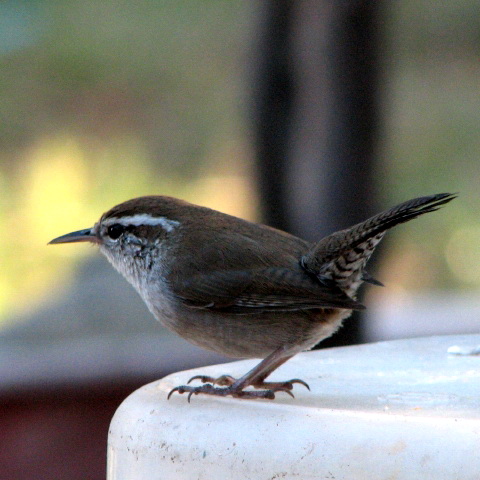Bewick's Wren (Thryomanes bewickii) - wiki Bewick's Wren
From Wikipedia, the free encyclopedia
[Photo] Dec-2005 --j/p thomas
The Bewick's Wren (Thryomanes bewickii) is a wren native to North America. At about 14cm long, it is gray-brown above, white below, with a long white eyebrow. While similar in appearance to the Carolina Wren, it has a long tail that is tipped in white. The song is loud and melodious, much like the song of other wrens. It lives in thickets, brush piles and hedgerows, open woodlands and scrubby areas, often near streams. Its range is from southern British Columbia, Nebraska, southern Ontario, and southwestern Pennsylvania south to Mexico, Arkansas and the northern Gulf States. It usually lays 5-7 eggs that are white with brown spots.
This is currently the only species of its genus, Thryomanes. The Socorro Wren, formerly placed here too, is actually a close relative of the House Wren complex, as indicated by biogeography and mtDNA NADH dehydrogenase subunit 2 sequence analysis, whereas Thryomanes seems not too distant from the Carolina Wren (Mart??nez G??mez et al. 2005).
Subspecies
A list of commonly recognized subspecies follows. Two have gone extinct during the 20th century due to habitat destruction and cat predation (Kennedy & White, 1997).
T. b. bewickii (Audubon). Midwestern USA from NE Kansas to Missouri and E Texas. Includes T. b. pulichi as a junior synonym.
T. b. altus Aldrich. Formerly in Appalachian region; S Ontario to South Carolina, now quite rare. Possibly an endangered subspecies, but possibly not distinct from bewickii.
T. b. cryptus Oberholser. Central Kansas to N Tamaulipas in Mexico. Includes T. b. niceae. Southeastern birds are sometimes separated as T. b. sadai.
T. b. eremophilus Oberholser. E California inland, south to Zacatecas in Mexico.
T. b. calophonus Oberholser. SW British Columbia, Canada, to W Oregon. Includes T. b. ariborius and T. b. hurleyi. The former name refers to the population found in the area of Seattle and Vancouver; these birds are sometimes called Seattle Wren.
T. b. marinensis Grinnell. Coastal NW California to Marin County.
T. b. spilurus (Vigors). Coastal California from San Francisco Bay to Santa Cruz County.
T. b. drymoecus Oberholser. SW Oregon to California Central Valley.
T. b. atrestus Oberholser. S Oregon to W Nevada. Probably not valid.
T. b. correctus Grinnell. SW coastal California to Mexican border; possibly synonym of charienturus.
T. b. charienturus Oberholser. N Baja California Peninsula to about 30°N.
T. b. magdalenensis Huey. SW Baja California Peninsula from 26 to 24°N.
T. b. nesophilus Oberholser. Santa Rosa, Santa Cruz, and Anacapa Islands, California; probably also Santa Barbara and San Nicolas; found on the mainland in winter. Possibly synonym of charienturus.
T. b. catalinae Grinnell. Santa Catalina Island, California; found on the mainland in winter. Possibly synonym of charienturus.
T. b. cerroensis (Anthony). Cedros Island (Mexico) and W central Baja California. Includes T. b. atricauda.
T. b. leucophrys (Anthony). San Clemente Bewick's Wren. Formerly San Clemente Island, California.
Extinct since the 1940s due to habitat destruction by feral goats and sheep. Also called T. b. anthonyi. Kaeding's (1905) observations of leucophrys in 1897 refer to cerroensis; at that time, the San Clemente wren was considered a good species which included the Cedros population.
T. b. brevicauda Ridgway. Guadalupe Bewick's Wren. Formerly Guadalupe Island, Mexico.
This subspecies is extinct since the 1900s due to habitat destructioin by feral goats and predation by feral cats. It was "nearly extinct" in March, 1897 (Kaeding, 1905), and last seen in 1903.
T. b. murinus (Hartlaub). Eastern and central Mexico.
T. b. bairdi (Salvin and Goodman). SE Mexico to S Puebla.
T. b. percnus (Oberholser). Jalisco to Guerrero, Mexico.
The last three are sometimes united as T. b. mexicanus. The validity of subspecies needs to be verified using freshly-caught birds and/or molecular evidence, as specimens are prone to acquiring a more reddish-brown coloration quickly (Kennedy & White, 1997).
Interesting Bewick’s Wren Facts
The population of Bewick’s Wren has declined rapidly in the Eastern United States. Experts believe this might be due to the rapid increase in the House Wren population, which removes eggs from the nest of other species.
Male Bewick’s Wrens learn how to sing not from their fathers but instead from their neighbors.
Some male Bewick’s Wrens attack nests of fellow Bewick’s Wrens as well as birds of other species.
Bewick's Wren was named by John James Audubon after Thomas Bewick, an English ornithologist and engraver.
http://en.wikipedia.org/wiki/Bewick%27s_Wren
| The text in this page is based on the copyrighted Wikipedia article shown in above URL. It is used under the GNU Free Documentation License. You may redistribute it, verbatim or modified, providing that you comply with the terms of the GFDL. |
